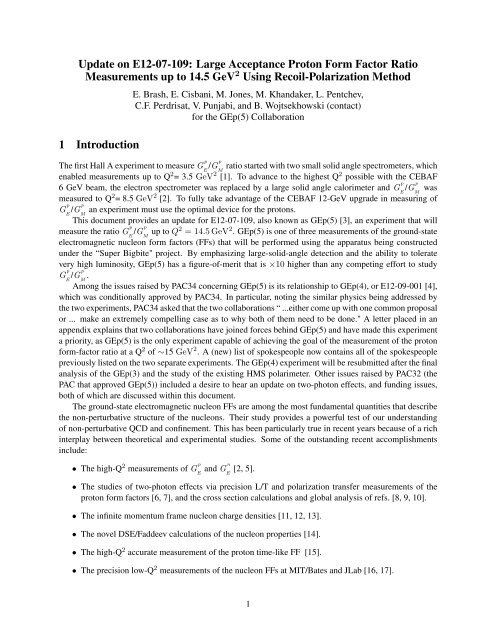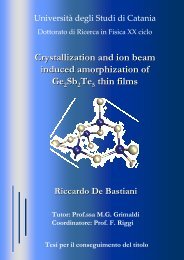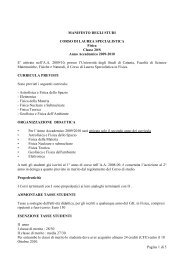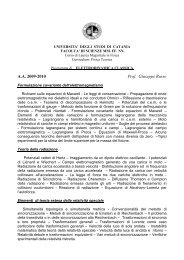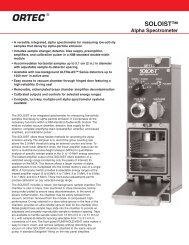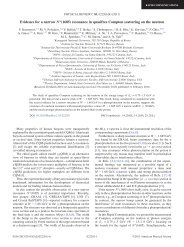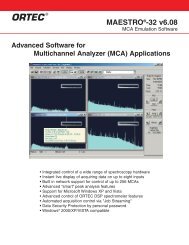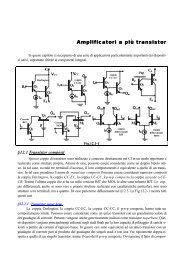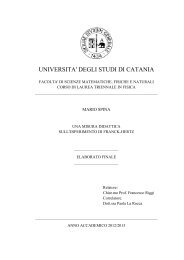Update on E12-07-109: Large Acceptance Proton Form Factor ... - Infn
Update on E12-07-109: Large Acceptance Proton Form Factor ... - Infn
Update on E12-07-109: Large Acceptance Proton Form Factor ... - Infn
Create successful ePaper yourself
Turn your PDF publications into a flip-book with our unique Google optimized e-Paper software.
<str<strong>on</strong>g>Update</str<strong>on</strong>g> <strong>on</strong> <strong>E12</strong>-<strong>07</strong>-<strong>109</strong>: <strong>Large</strong> <strong>Acceptance</strong> Prot<strong>on</strong> <strong>Form</strong> <strong>Factor</strong> Ratio<br />
Measurements up to 14.5 GeV 2 Using Recoil-Polarizati<strong>on</strong> Method<br />
1 Introducti<strong>on</strong><br />
E. Brash, E. Cisbani, M. J<strong>on</strong>es, M. Khandaker, L. Pentchev,<br />
C.F. Perdrisat, V. Punjabi, and B. Wojtsekhowski (c<strong>on</strong>tact)<br />
for the GEp(5) Collaborati<strong>on</strong><br />
The first Hall A experiment to measure G p p<br />
/G ratio started with two small solid angle spectrometers, which<br />
E M<br />
enabled measurements up to Q2 = 3.5 GeV2 [1]. To advance to the highest Q2 possible with the CEBAF<br />
6 GeV beam, the electr<strong>on</strong> spectrometer was replaced by a large solid angle calorimeter and G p p<br />
/G E M was<br />
measured to Q2 = 8.5 GeV2 [2]. To fully take advantage of the CEBAF 12-GeV upgrade in measuring of<br />
G p p<br />
/G an experiment must use the optimal device for the prot<strong>on</strong>s.<br />
E M<br />
This document provides an update for <strong>E12</strong>-<strong>07</strong>-<strong>109</strong>, also known as GEp(5) [3], an experiment that will<br />
measure the ratio G p p<br />
/G E M up to Q2 = 14.5 GeV2 . GEp(5) is <strong>on</strong>e of three measurements of the ground-state<br />
electromagnetic nucle<strong>on</strong> form factors (FFs) that will be performed using the apparatus being c<strong>on</strong>structed<br />
under the “Super Bigbite" project. By emphasizing large-solid-angle detecti<strong>on</strong> and the ability to tolerate<br />
very high luminosity, GEp(5) has a figure-of-merit that is ×10 higher than any competing effort to study<br />
G p<br />
E<br />
/G p<br />
M .<br />
Am<strong>on</strong>g the issues raised by PAC34 c<strong>on</strong>cerning GEp(5) is its relati<strong>on</strong>ship to GEp(4), or <strong>E12</strong>-09-001 [4],<br />
which was c<strong>on</strong>diti<strong>on</strong>ally approved by PAC34. In particular, noting the similar physics being addressed by<br />
the two experiments, PAC34 asked that the two collaborati<strong>on</strong>s “ ...either come up with <strong>on</strong>e comm<strong>on</strong> proposal<br />
or ... make an extremely compelling case as to why both of them need to be d<strong>on</strong>e." A letter placed in an<br />
appendix explains that two collaborati<strong>on</strong>s have joined forces behind GEp(5) and have made this experiment<br />
a priority, as GEp(5) is the <strong>on</strong>ly experiment capable of achieving the goal of the measurement of the prot<strong>on</strong><br />
form-factor ratio at a Q 2 of ∼15 GeV 2 . A (new) list of spokespeople now c<strong>on</strong>tains all of the spokespeople<br />
previously listed <strong>on</strong> the two separate experiments. The GEp(4) experiment will be resubmitted after the final<br />
analysis of the GEp(3) and the study of the existing HMS polarimeter. Other issues raised by PAC32 (the<br />
PAC that approved GEp(5)) included a desire to hear an update <strong>on</strong> two-phot<strong>on</strong> effects, and funding issues,<br />
both of which are discussed within this document.<br />
The ground-state electromagnetic nucle<strong>on</strong> FFs are am<strong>on</strong>g the most fundamental quantities that describe<br />
the n<strong>on</strong>-perturbative structure of the nucle<strong>on</strong>s. Their study provides a powerful test of our understanding<br />
of n<strong>on</strong>-perturbative QCD and c<strong>on</strong>finement. This has been particularly true in recent years because of a rich<br />
interplay between theoretical and experimental studies. Some of the outstanding recent accomplishments<br />
include:<br />
• The high-Q 2 measurements of G p<br />
E<br />
n<br />
and G [2, 5].<br />
E<br />
• The studies of two-phot<strong>on</strong> effects via precisi<strong>on</strong> L/T and polarizati<strong>on</strong> transfer measurements of the<br />
prot<strong>on</strong> form factors [6, 7], and the cross secti<strong>on</strong> calculati<strong>on</strong>s and global analysis of refs. [8, 9, 10].<br />
• The infinite momentum frame nucle<strong>on</strong> charge densities [11, 12, 13].<br />
• The novel DSE/Faddeev calculati<strong>on</strong>s of the nucle<strong>on</strong> properties [14].<br />
• The high-Q 2 accurate measurement of the prot<strong>on</strong> time-like FF [15].<br />
• The precisi<strong>on</strong> low-Q 2 measurements of the nucle<strong>on</strong> FFs at MIT/Bates and JLab [16, 17].<br />
1
Indeed, the measurements described by J<strong>on</strong>es et al. in Ref. [1] represent <strong>on</strong>e of the most striking results<br />
to come out of JLab. It was found that the ratio of the electric and magnetic form factors of the prot<strong>on</strong>,<br />
G p p<br />
/G E M , decreases approximately linearly with four-momentum transfer, Q2 , for values above roughly<br />
1 GeV2 . Prior to this observati<strong>on</strong>, the widely held expectati<strong>on</strong> was that this ratio would be roughly c<strong>on</strong>stant.<br />
The experimental result has stimulated enormous interest and the initial paper announcing the discovery<br />
has received almost 500 citati<strong>on</strong>s. It is widely held that these observati<strong>on</strong>s have forced a rec<strong>on</strong>siderati<strong>on</strong> of<br />
nucle<strong>on</strong> structure. And as is clear from some of the theoretical work menti<strong>on</strong>ed in the above list, the emerging<br />
picture of the nucle<strong>on</strong> c<strong>on</strong>tains important properties that were not well recognized previously. Am<strong>on</strong>g<br />
them is the dynamical importance of quark orbital angular momentum (OAM). It is also notable that ab<br />
initio calculati<strong>on</strong>s of form factors using lattice QCD have become increasingly accurate, and have reached<br />
to increasingly high values of Q2 , thus providing yet another reas<strong>on</strong> to study ground-state form factors.<br />
As will be discussed further in the next secti<strong>on</strong>, recent advances in hadr<strong>on</strong>ic physics have not been c<strong>on</strong>fined<br />
to the study of the ground-state nucle<strong>on</strong> form factors. Other examples have included observati<strong>on</strong>s in<br />
both inclusive and semi-inclusive deep inelastic scattering (DIS) that have provided new tests of our understanding<br />
of nucle<strong>on</strong> structure in terms of QCD degrees of freedom. Interestingly, the dynamical importance<br />
of quark OAM has emerged independently in a number of these experiments. We note also that the value<br />
of studies at high Q2 has been seen outside of studies of the nucle<strong>on</strong>, such as in recent measurements by<br />
BABAR of the transiti<strong>on</strong> form factor of the pi<strong>on</strong> [18] where large deviati<strong>on</strong>s from the predicti<strong>on</strong>s of perturbative<br />
QCD were observed. The emergence of generalized part<strong>on</strong> distributi<strong>on</strong>s (GPDs) has also been<br />
of enormous importance, providing a single framework within which both DIS measurements and formfactor<br />
measurements can be understood. GPDs provide new insight into nucle<strong>on</strong> structure, and form-factor<br />
measurements provide critical c<strong>on</strong>straints to their parameterizati<strong>on</strong>.<br />
Summarizing these remarks, the present situati<strong>on</strong> is both dynamic and exciting. On <strong>on</strong>e side, the theoretical<br />
ideas and methods are rapidly advancing, and <strong>on</strong> the other side, experiments have discovered new<br />
and unexpected features which significantly alter the prevailing descripti<strong>on</strong> of nucle<strong>on</strong> structure. Looking<br />
forward, the key to expanding our understanding of the underlying quark structure of the nucle<strong>on</strong> is to make<br />
measurements in a regime where the theoretical predicti<strong>on</strong>s str<strong>on</strong>gly diverge from <strong>on</strong>e another, and where<br />
simplificati<strong>on</strong>s occur that aid in the interpretati<strong>on</strong> of the data. All these arguments underscore the importance<br />
of reaching high Q2 while simultaneously maintaining high precisi<strong>on</strong>. A novel experimental design<br />
is needed if running times are to remain reas<strong>on</strong>able [19, 20].<br />
2 The scientific case for the proposal<br />
A comm<strong>on</strong> thread in virtually all of the theoretical explanati<strong>on</strong>s of the Q2-dependence of G p p<br />
/G is an<br />
E M<br />
important role for quark orbital angular momentum (quark OAM) in the nucle<strong>on</strong>’s dynamics. What is remarkable<br />
is that evidence for quark OAM has begun showing up in other processes as well. For example,<br />
measurements of the DIS spin asymmetry An 1 for the neutr<strong>on</strong> [21] were performed at high values of Bjorken<br />
x where both relativistic quark models and pQCD provide predicti<strong>on</strong>s. The pQCD predicti<strong>on</strong>s assumed<br />
hadr<strong>on</strong> helicity c<strong>on</strong>servati<strong>on</strong>, which implicitly imbeds the noti<strong>on</strong> that quark OAM is not playing a significant<br />
role. What was observed was that An 1 was in disagreement with the pQCD predicti<strong>on</strong>, but in reas<strong>on</strong>able<br />
agreement with the quark models which implicitly include the noti<strong>on</strong> that quark OAM has dynamical importance.<br />
All of this was taking place as data <strong>on</strong> single-spin asymmetries from HERMES and COMPASS were<br />
showing new unanticipated effects. Subsequent interpretati<strong>on</strong> in terms of the so-called Sivers mechanism<br />
again suggests, here quite unambiguously, an important dynamical role for quark OAM. Data from SPIN<br />
RHIC seem to suggest that the c<strong>on</strong>tributi<strong>on</strong> to the nucle<strong>on</strong> spin from the spins of glu<strong>on</strong>s, ∆G, is not nearly<br />
as large as was <strong>on</strong>ce thought possible. While SPIN RHIC has <strong>on</strong>ly studied a limited range in Bjorken x, the<br />
results thus far are c<strong>on</strong>sistent with ∆G being equal to zero. The RHIC results highlight the fact that we still<br />
2
do not understand the compositi<strong>on</strong> of the spin of the nucle<strong>on</strong>. With polarized DIS results suggesting that<br />
<strong>on</strong>ly 20-30% of the spin of the nucle<strong>on</strong> is due to the spin of the quarks, it is certainly possible that some of<br />
the remaining spin is due to quark OAM. The fracti<strong>on</strong> of the nucle<strong>on</strong> spin due to quark OAM is sometimes<br />
designated as ∆Lq. While recent observati<strong>on</strong>s of the dynamical importance of quark OAM do not yet yield<br />
definite values for ∆Lq, they may be suggesting that this quantity is quite substantial.<br />
In Fig. 1 we show existing data for G p p<br />
/G , the projected errors for GEp(5), and the results of several<br />
E M<br />
theoretical calculati<strong>on</strong>s 1 . The figure makes it clear that the <strong>on</strong>ly way to achieve clarity in discriminating<br />
between theoretical explanati<strong>on</strong>s of the G p p<br />
/G data is to measure the prot<strong>on</strong> form factor ratio with<br />
E M<br />
c<strong>on</strong>siderable precisi<strong>on</strong> to high values of Q2 .<br />
p<br />
M<br />
/G<br />
p<br />
E<br />
G<br />
p<br />
µ<br />
1.0<br />
0.5<br />
0.0<br />
-0.5<br />
GEp(1)<br />
GEp(2)<br />
GEp(3) (prelim, stat <strong>on</strong>ly)<br />
GEp(5) <strong>E12</strong>-<strong>07</strong>-<strong>109</strong>, SBS<br />
VMD - E. Lom<strong>on</strong> (2002)<br />
VMD - Bijker and Iachello (2004)<br />
RCQM - G. Miller (2002)<br />
DSE - C. Roberts (2009)<br />
F2/F<br />
∝ 1<br />
2 2 2<br />
(Q / Λ )/Q , Λ = 300 MeV<br />
0 5 10<br />
2 2<br />
Q in GeV<br />
15<br />
Figure 1: Shown are existing data for the ratio G p p<br />
/G together with the projected errors of GEp(5). Included<br />
E M<br />
are the published results of GEp(1) [26] and GEp(2) [27], preliminary results from GEp(3) [2], and the<br />
projected results of GEp(5) during a 60-day run. The various theoretical curves are discussed in the text.<br />
For example, three of the predicti<strong>on</strong>s shown, the relativistic c<strong>on</strong>stituent quark model (RCQM, Miller<br />
2002) [22], the DSE/Faddeev calculati<strong>on</strong> [14], and the refined pQCD calculati<strong>on</strong> (F2/F1 ∝ ln 2 (Q2 /Λ2 )/Q2 ) [23],<br />
all predict G p p<br />
/G E M to cross zero somewhere in the neighborhood of Q2≈ 7 GeV2 . At the same time, the two<br />
vector-mes<strong>on</strong> dominance (VMD) models show G p p<br />
/G approaching zero much more gradually [24, 25].<br />
E M<br />
GEp(1) and GEp(2) agree reas<strong>on</strong>ably well with all of these predicti<strong>on</strong>s. In c<strong>on</strong>trast, the preliminary GEp(3)<br />
data appear to favor the VMD models. A definitive resoluti<strong>on</strong> to this issue has profound physical implicati<strong>on</strong>s,<br />
and cannot occur without high-precisi<strong>on</strong> data at high Q2 . We note in passing that the new (near-final)<br />
results from GEn(1) tend to favor the DSE/Fadeev and RCQM calculati<strong>on</strong>s over the VMD models. Indeed,<br />
it appears that form-factor measurements are at the cusp of obtaining crisp answers to the host of questi<strong>on</strong>s<br />
that were first opened by the work of J<strong>on</strong>es et al. in Ref. [1].<br />
There are, of course, many additi<strong>on</strong>al motivati<strong>on</strong>s for measuring the ground-state prot<strong>on</strong> form factors<br />
that are not illustrated in Fig. 1. For instance, the ground-state elastic form factors provide stringent modelindependent<br />
c<strong>on</strong>straints <strong>on</strong> Generalized Part<strong>on</strong> Distributi<strong>on</strong>s, GPDs. Thus, if we want to know the GPDs<br />
over a wide kinematic range, we need to study the elastic form factors over a similar range. We note<br />
that GPDs provide a powerful opportunity to determine quark angular momentum in a model-independent<br />
fashi<strong>on</strong>. Also, the elastic form factors also provide a powerful check of lattice QCD. As menti<strong>on</strong>ed above, ab<br />
1 The projected points of the GEp(4) experiment are not shown because they will be re-formulated later as explained in the letter<br />
placed in an appendix to this document.<br />
3<br />
ln<br />
2
initio lattice calculati<strong>on</strong>s of ground-state form factors are making impressive progress, and the comparis<strong>on</strong><br />
of these results with experimental measurements is extremely important.<br />
Setting aside specific models, there is also an experimental questi<strong>on</strong> regarding the behavior of G p p<br />
/G E M<br />
that is of great importance. The linearity of the data for G p p<br />
/G E M up to Q2≈ 6 GeV2 is very striking, but to<br />
what value of Q2 will this linearity c<strong>on</strong>tinue? Looking again at Fig. 1, the preliminary results from GEp(3),<br />
up to values of around Q2 =8.6 GeV2 , appear to be breaking somewhat with the earlier trend, that is, the rate<br />
of decline of G p p<br />
/G appears to be slowing. It is hard to be certain, however, because the preliminary errors<br />
E M<br />
are relatively large. By going to Q2 =14.5 GeV2 , the trend of G p p<br />
/G should become clear, but <strong>on</strong>ly if the<br />
E M<br />
data have sufficient precisi<strong>on</strong>. Such precisi<strong>on</strong> is offered by the present experiment, which has a figure-ofmerit<br />
10 times higher than any other proposed experiments or possible with other equipment than the SBS<br />
spectrometer.<br />
The striking linear behavior of G p p<br />
/G is important informati<strong>on</strong> for both present and future theoretical<br />
E M<br />
formulati<strong>on</strong>s, particularly given that it is in disagreement with QCD scaling relati<strong>on</strong>s (predicting the ratio<br />
G p<br />
E<br />
G p<br />
E<br />
/G p<br />
M to be c<strong>on</strong>stant) that are believed to be valid at sufficiently high values of Q2 . The shape of the ratio<br />
/G p<br />
M up to Q2 =14.5 GeV 2 will provide critical guidance to an area in which, presently, there are many<br />
open questi<strong>on</strong>s.<br />
In the years following the discovery by J<strong>on</strong>es et al., it is not surprising that models evolved that explained<br />
well the existing prot<strong>on</strong> data. It is also not surprising that these models diverge str<strong>on</strong>gly at high-Q 2<br />
where there is no data to c<strong>on</strong>strain the calculati<strong>on</strong>s. Higher values of Q 2 also offer the advantage of certain<br />
theoretical simplificati<strong>on</strong>s. For example, the role of vector mes<strong>on</strong>s is suppressed at higher Q 2 , as are higher<br />
Fock states in the phenomenological models of GPDs. At high Q 2 there is increased clarity, and increased<br />
discovery potential, and GEp(5) provides an excellent opportunity to explore this regi<strong>on</strong>.<br />
3 The c<strong>on</strong>cept of the experiment<br />
Elastic scattering of the l<strong>on</strong>gitudinally polarized 11 GeV electr<strong>on</strong>s from the liquid hydrogen target will be<br />
used, H(e,e’p). Polarizati<strong>on</strong> transfer to the recoiling prot<strong>on</strong> provides a measure of the G p p<br />
/G as proposed<br />
E M<br />
in the double-polarizati<strong>on</strong> method [28]. In measuring of the nucle<strong>on</strong> FF ratio, this method mitigates the<br />
difficulties of the Rosenbluth separati<strong>on</strong> method at high momentum transfer and is almost insensitive to<br />
the two-phot<strong>on</strong> effects. The most effective realizati<strong>on</strong> of the double-polarizati<strong>on</strong> approach for the large<br />
momentum transfer G p p<br />
/G -ratio experiments was proposed in Ref. [29], which is based <strong>on</strong> combinati<strong>on</strong> of<br />
E M<br />
the spin precessi<strong>on</strong> in the magnetic spectrometer followed by a polarimeter. This provides directly the ratio<br />
of the polarizati<strong>on</strong> comp<strong>on</strong>ents of the prot<strong>on</strong> and has a high figure-of-merit as well as a cancellati<strong>on</strong> of most<br />
systematic uncertainties related to the polarimeter analyzing power and the efficiency.<br />
The formalism: In the <strong>on</strong>e-phot<strong>on</strong> exchange approximati<strong>on</strong>, the scattering of l<strong>on</strong>gitudinally polarized<br />
electr<strong>on</strong>s from unpolarized hydrogen results in a transfer of polarizati<strong>on</strong> to the recoiling prot<strong>on</strong> with two<br />
comp<strong>on</strong>ents, Pt perpendicular to, and Pℓ parallel to the prot<strong>on</strong> momentum in the scattering plane [28]<br />
Pt = −<br />
<br />
where σred is the reduced cross-secti<strong>on</strong> G 2<br />
M<br />
angle, and τ = Q 2 /4M 2 p .<br />
2ε(1 − ε) GM G<br />
<br />
E<br />
, Pl =<br />
τ σred<br />
(1 − ε 2 ) G2<br />
M<br />
σred<br />
θe<br />
+ εG2 /τ, ε = [1 + 2(1 + τ) tan2 E 2 ]−1 , θe is the lab electr<strong>on</strong><br />
4<br />
(1)
Measuring these two comp<strong>on</strong>ents simultaneously and taking their ratio gives the ratio of the form factors<br />
GE GM = − Pt<br />
Pl<br />
<br />
τ(1 + ε)<br />
2ε<br />
Using the double-polarizati<strong>on</strong> technique, the form factor ratio GE/GM at a given Q 2 can be obtained without<br />
measuring the absolute cross secti<strong>on</strong>s and without change of beam energy or detector angle, thus eliminating<br />
important sources of systematic uncertainties. Note that the analyzing power of the polarimeter and the beam<br />
polarizati<strong>on</strong> that come into an actual measurement of Pt and Pℓ cancel out in Eq. 2, and thus do not need<br />
to be known particularly well. They do affect the size of the measured asymmetries, however, so they still<br />
need to be maximized to increase the experimental figure-of-merit.<br />
The experimental c<strong>on</strong>siderati<strong>on</strong>s: We recall that in the GEp(5) experiment the scattered electr<strong>on</strong> will be<br />
detected via the segmented lead-glass calorimeter and the recoiling prot<strong>on</strong> via the Super Bigbite Spectrometer<br />
(SBS) in Hall A (Fig 2). The apparatus has a double polarimeter to measure the polarizati<strong>on</strong> of the<br />
recoiling prot<strong>on</strong>.<br />
.<br />
Beam<br />
Prot<strong>on</strong> form factors ratio, GEp(5) (<strong>E12</strong>-<strong>07</strong>-<strong>109</strong>)<br />
Target<br />
Electr<strong>on</strong> Arm<br />
Al filter<br />
Prot<strong>on</strong> Arm<br />
INFN<br />
BNL<br />
BigBen GEM<br />
GEM<br />
48D48<br />
GEM<br />
GEM<br />
BigCal<br />
Lead-Glass<br />
Calorimeter<br />
Figure 2: The left panel shows an SBS c<strong>on</strong>figurati<strong>on</strong> for the <strong>E12</strong>-<strong>07</strong>-<strong>109</strong> experiment (artists view): 40 cm<br />
LH2 target with a vacuum chamber, 48D48 magnet, three GEM trackers and two CH2 analyzers, and a<br />
hadr<strong>on</strong> calorimeter. Visible is the cut of the magnet for the beam line. The right panel shows a top view of<br />
the experiment’s layout.<br />
At high momentum transfer the coincidence between recoiling prot<strong>on</strong> and scattered electr<strong>on</strong> is required<br />
for identificati<strong>on</strong> of elastic scattering from a much larger number of inelastic events. Due to kinematical<br />
correlati<strong>on</strong>s between electr<strong>on</strong> and prot<strong>on</strong>, the planned large acceptance detecti<strong>on</strong> system could be c<strong>on</strong>sidered<br />
as a large number of spectrometers effectively increasing the experiment’s productivity.<br />
The basic equipment: The scattered electr<strong>on</strong> will be detected, in coincidence with the prot<strong>on</strong> arm, in the<br />
lead-glass calorimeter BigCal originally c<strong>on</strong>structed for GEp(3) [2]. The recoiling prot<strong>on</strong> will be detected<br />
in a new large acceptance magnetic Super Bigbite spectrometer, SBS.<br />
The new and key part of the detector is a set of tracking chambers using Gas Electr<strong>on</strong> Multipliers (GEM)<br />
for the SBS trackers. The GEM chambers are c<strong>on</strong>ceptually similar to the <strong>on</strong>es used in the COMPASS<br />
5<br />
(2)<br />
HCalo<br />
.
experiment at CERN. A two-plane GEM chamber with <strong>on</strong>e-dimensi<strong>on</strong>al readout will be installed in fr<strong>on</strong>t of<br />
BigCal. The very high rates associated with the SBS detector c<strong>on</strong>figurati<strong>on</strong> are tolerable because of the use<br />
of a GEM-based tracking system. The feasibility of such an open geometry design has been unambiguously<br />
dem<strong>on</strong>strated in multiple experiments using Super Bigbite’s predecessor, BigBite. The complete descripti<strong>on</strong><br />
of the M<strong>on</strong>te Carlo simulati<strong>on</strong>s and data analysis are presented in Ref. [19].<br />
Another new detector will be a hadr<strong>on</strong> calorimeter, HCalo, which will be used for triggering in coincidence<br />
with BigCal. The individual counter of the hadr<strong>on</strong> calorimeter is similar to the <strong>on</strong>es used in the<br />
COMPASS experiment at CERN.<br />
The dipole magnet of SBS is available from the fixed-target AGS program at BNL. The dipole will<br />
bend elastically scattered recoiling prot<strong>on</strong>s by 6 degrees upwards, while background charged particles with<br />
momenta below 0.3 GeV will be swept out of the tracking detectors. A cutout in the SBS magnet allows<br />
for the use of forward angles down to 12 ◦ where the recoiling prot<strong>on</strong>s need to be detected with a large solid<br />
angle.<br />
The prot<strong>on</strong> spin will precess by an angle close to the optimum value of 90 ◦ . A track of the prot<strong>on</strong> will<br />
be recorded three times: first in the tracker after the dipole magnet, then in the sec<strong>on</strong>d and third trackers<br />
after the first and sec<strong>on</strong>d analyzers (50 cm CH2 each).<br />
4 Technical progress toward realizing the experiment<br />
During the last several years significant efforts have been directed toward realizati<strong>on</strong> of the form-factor<br />
program in Hall A.<br />
Collaborati<strong>on</strong> and coordinati<strong>on</strong>: The proposal for this experiment was approved by PAC32 in August<br />
20<strong>07</strong> [30]. Understanding the importance of precise high-Q 2 measurements, the spokespers<strong>on</strong>s of the<br />
two prot<strong>on</strong> form-factor ratio experiments with 11 GeV beam, <strong>E12</strong>-<strong>07</strong>-<strong>109</strong> and <strong>E12</strong>-09-001, decided to<br />
c<strong>on</strong>solidate behind the GEp(5) experiment. Two new spokespers<strong>on</strong>s were added to the <strong>E12</strong>-<strong>07</strong>-<strong>109</strong> team<br />
and a coordinated plan of measurements was formulated (see attached letter).<br />
In November 2008 the SBS project was reviewed by a technical committee. The C<strong>on</strong>ceptual Design<br />
Report (CDR) and the technical review reports can be found in [19]. In last year’s PAC34, three additi<strong>on</strong>al<br />
experiments that will use the SBS were approved: the neutr<strong>on</strong> electric (<strong>E12</strong>-09-016) and magnetic (<strong>E12</strong>-<br />
09-019) form-factor measurements, and the c<strong>on</strong>diti<strong>on</strong>ally approved SIDIS experiment (<strong>E12</strong>-09-018). This<br />
makes the collaborati<strong>on</strong> behind the SBS project in Hall A much str<strong>on</strong>ger. A funding proposal [31] to DOE<br />
was submitted in November 2009 that will cover the whole experimental apparatus needed for all the three<br />
nucle<strong>on</strong> form-factor experiments: <strong>E12</strong>-<strong>07</strong>-<strong>109</strong>, <strong>E12</strong>-09-016, and <strong>E12</strong>-09-019.<br />
Funding of the project: In September 20<strong>07</strong> the Italian institute INFN approved the development and<br />
c<strong>on</strong>structi<strong>on</strong> of the fr<strong>on</strong>t tracker for the Super Bigbite for the total amount of 720k. The request for SBS<br />
funding was submitted by the Glasgow University group (Prof. G. Rosner) to the UK STFC for the amount<br />
of $200k. The collaborati<strong>on</strong> submitted a funding request [31] to DOE for the amount of $2.4M (detectors<br />
of the SBS project) and for the amount of $1.4M (the magnet and Hall A infrastructure).<br />
Magnet design: The magnet c<strong>on</strong>figurati<strong>on</strong> was analyzed with 3D field calculati<strong>on</strong>s [32]. The magnet will<br />
be used with an excitati<strong>on</strong> current of 2 kA, which is half of the nominal value of the original 48D48 magnet.<br />
Therefore, the cross secti<strong>on</strong> of the new coils will be reduced. It was dem<strong>on</strong>strated that for the required main<br />
field al<strong>on</strong>g the central trajectory of 2.5 T·m, the field inside the beam line will have a transverse comp<strong>on</strong>ent<br />
below 200 Gauss, and its integral will be <strong>on</strong> the level of 0.005 T·m, which have very little effect <strong>on</strong> the<br />
11 GeV beam and the backgound rate in the detectors of the SBS apparatus. The power supply of the<br />
QWeak experiment will be used to energize the SBS magnet.<br />
6
GEM chamber design and prototyping: The actual design of the GEM chamber is proceeding at INFN<br />
by the Roma group. Both the electr<strong>on</strong>ics and the GEM readout board for the 40×50 cm 2 unit are in the<br />
prototyping stage. All APV25 chips required for the SBS trackers have already been purchased. In 2010 the<br />
actual size prototype GEM chamber will be tested in Hall A.<br />
JLab in collaborati<strong>on</strong> with GU has already c<strong>on</strong>structed and tested small GEM chambers which were<br />
used for initial studies in Hall A. The UVa group is preparing two small chambers with readout electr<strong>on</strong>ics<br />
for use during the PREX experiment (Hall A, April 2010) in the HRS spectrometers.<br />
Calorimeters: The existing lead-glass calorimeter BigCal was successfully used in four experiments in<br />
Hall C. The UV curing procedure that is planned to be used in the GEp(5) experiment was tested several<br />
times during these experiments. The detector will be re-stacked, increasing the vertical aspect ratio, but<br />
keeping the same number of channels and total area. The electr<strong>on</strong> arm will be equipped with a two-plane<br />
GEM chamber in fr<strong>on</strong>t of BigCal and behind a 20-cm Al absorber.<br />
Collaborati<strong>on</strong> with the Dubna group (Prof. I. Savin) was organized for the design and c<strong>on</strong>structi<strong>on</strong> of<br />
the hadr<strong>on</strong> calorimeter. A M<strong>on</strong>te Carlo simulati<strong>on</strong> of the HCalo calorimeter was performed for a few GeV<br />
prot<strong>on</strong>s, neutr<strong>on</strong>s, and pi<strong>on</strong>s. The M<strong>on</strong>te Carlo simulati<strong>on</strong> was also used to find the counting rate of the<br />
detector by using the DINREG event generator [33].<br />
Simulati<strong>on</strong>s: New features were included in the simulati<strong>on</strong> of the elastic events that made it possible to<br />
optimize the detector c<strong>on</strong>figurati<strong>on</strong>.<br />
Based <strong>on</strong> the results from the double polarimeter in the GEp(3) experiment, the scattering of the polarized<br />
prot<strong>on</strong>s in the analyzers was simulated and an analyzing power was assigned for each event. Thus,<br />
the polarimeter figure-of-merit, F OM = ε(θ)A2 (θ), where ε(θ) is the efficiency for a scattering angle θ<br />
Y<br />
and AY is the analyzing power, was calculated event by event and used to optimize the geometrical sizes<br />
of the detectors. We modified the geometrical sizes of the trackers and the two calorimeters to increase the<br />
elastic event rate per unit Q2 interval. This was achieved by increasing the vertical to horiz<strong>on</strong>tal aspect ratio<br />
to about 3:1, which was possible after rec<strong>on</strong>figuring the coils of the magnet as explained above. Advanced<br />
simulati<strong>on</strong> of the π◦ photoproducti<strong>on</strong>, the main physical background, has been performed. It dem<strong>on</strong>strated<br />
that the detector resoluti<strong>on</strong>s will allow us to reduce this background to a few percents.<br />
Trigger c<strong>on</strong>figurati<strong>on</strong>: A Flash ADC was developed by the JLab electr<strong>on</strong>ics group. It was used successfully<br />
for the Gas Cherenkov counter of the BigBite spectrometer and currently in the detector of the Möller<br />
polarimeter. We plan to implement 16 such FADCs in the readout of the hadr<strong>on</strong> calorimeter. A detailed<br />
design of the trigger logic based <strong>on</strong> the FADC and FPGA logic was developed [19].<br />
The polarimeter measurements at JINR: An experimental study of the analyzing power is under way<br />
at JINR(Dubna). It will be d<strong>on</strong>e with a 7-8 GeV/c polarized prot<strong>on</strong> beam. A set of 25 hadr<strong>on</strong> calorimeter<br />
blocks will be used for the triggering as in the GEp(5) experiment.<br />
5 Two-phot<strong>on</strong> exchange update<br />
The JLab PAC32 report approving this experiment required an update <strong>on</strong> the two-phot<strong>on</strong> exchange effects.<br />
The two-phot<strong>on</strong> exchange c<strong>on</strong>tributi<strong>on</strong> has been shown to be an important term to add to the standard radiative<br />
correcti<strong>on</strong>s for cross secti<strong>on</strong> data; it has a str<strong>on</strong>g ɛ-dependence and brings the Rosenbluth form-factor<br />
ratio closer to the recoil-polarizati<strong>on</strong> results. At the same time, two-phot<strong>on</strong> c<strong>on</strong>tributi<strong>on</strong>s are expected to<br />
affect the recoil-polarizati<strong>on</strong> results <strong>on</strong>ly very weakly. The preliminary results (Fig. 3) from the recent GEp-<br />
2γ experiment [7] at Q 2 = 2.5 GeV 2 are c<strong>on</strong>sistent with two-phot<strong>on</strong> exchange calculati<strong>on</strong>s which explain<br />
the cross secti<strong>on</strong> data and predict a small effect <strong>on</strong> Pt/Pl. No other experimental results investigating the<br />
two-phot<strong>on</strong> exchange effects are available at this time. Hadr<strong>on</strong>ic [9], GPD [34] two-phot<strong>on</strong> exchange calculati<strong>on</strong>s,<br />
and recent pQCD calculati<strong>on</strong>s [35] are shown <strong>on</strong> the same plot. As shown in the original proposal<br />
7
0.76<br />
0.74<br />
0.72<br />
0.7<br />
0.68<br />
0.66<br />
0.64<br />
0.62<br />
0.6<br />
0.58<br />
!G E /G M 2.5 GeV 2<br />
BLW<br />
hadr<strong>on</strong>ic<br />
GPD<br />
COZ LO pQCD<br />
Born approx.<br />
GEP-I 2.47 GeV 2<br />
GEP-2G PRELIMINARY<br />
0.56<br />
0 0.1 0.2 0.3 0.4 0.5 0.6 0.7 0.8 0.9 1<br />
!<br />
Figure 3: Preliminary result for the<br />
prot<strong>on</strong> form factor ratio measured in<br />
GEp-2γ experiment [7] as a functi<strong>on</strong> of<br />
the virtual phot<strong>on</strong> polarizati<strong>on</strong> ε. The<br />
plot shows also the GEp(1) [26] result<br />
and hadr<strong>on</strong>ic [9], GPD [34], and<br />
pQCD [35] two-phot<strong>on</strong> exchange calculati<strong>on</strong>s.<br />
Vertical lines indicate the<br />
lower limit of the validity of the corresp<strong>on</strong>ding<br />
calculati<strong>on</strong>s.<br />
for the GPD calculati<strong>on</strong>s, the two-phot<strong>on</strong> exchange effects increase very slowly with Q 2 . Interestingly, the<br />
pQCD calculati<strong>on</strong>s show the opposite: a slight decrease of the two-phot<strong>on</strong> effects with Q 2 .<br />
6 <str<strong>on</strong>g>Update</str<strong>on</strong>g>d kinematics of the measurements<br />
Q 2 Ebeam beam time pp θSBS Ee θBigCal ∆[ µGE/GM]<br />
GeV 2 GeV days GeV deg GeV deg<br />
optics 6.6 4 28.0<br />
5.0 6.6 1 3.48 28.0 3.94 26.3 0.023<br />
10.0 8.8 10 6.20 16.7 3.47 35.3 0.065<br />
14.5 11. 45 8.61 12.0 3.27 39.0 0.135<br />
Table 1: The kinematics of the proposed data points.<br />
Because of the importance of the precise measurements at high Q 2 , we decided to have <strong>on</strong>e precise<br />
measurement at 14.5 GeV 2 (instead of two neighboring points at 13 and 15 GeV 2 as in the original proposal)<br />
and two points at about 5 and 10 GeV 2 . This will be achieved by reducing the horiz<strong>on</strong>tal sizes of the<br />
detectors and thus, effectively reducing the Q 2 acceptance, but increasing the vertical aceptance and the<br />
event rates per unit Q 2 interval, while keeping the detector area and the number of channels the same.<br />
The optimized acceptance and use of beam time provides more power to discriminate am<strong>on</strong>g different<br />
theoretical predicti<strong>on</strong>s, while keeping the same total beam time as in the original proposal. The kinematical<br />
quantities and anticipated errors for these points are summarized in Table 1. Including four days for optical<br />
and spin transport studies, we have in total 60 days of beam <strong>on</strong> target, as it was requested in the approved<br />
experiment <strong>E12</strong>-<strong>07</strong>-<strong>109</strong>.<br />
8
References<br />
[1] M.K. J<strong>on</strong>es et al., Phys. Rev. Lett. 84, 1398 (2000).<br />
[2] Ch. Perdrisat, V. Punjabi, M. J<strong>on</strong>es, E. Brash et al., Jeffers<strong>on</strong> Lab experiment E04-108 (GEp(3)).<br />
[3] E. Brash, E. Cisbani, M. J<strong>on</strong>es, M. Khandaker, L. Pentchev, Ch. Perdrisat, V. Punjabi, and B. Wojtsekhowski<br />
et al., Jeffers<strong>on</strong> Lab experiment <strong>E12</strong>-<strong>07</strong>-<strong>109</strong> (GEp(5)).<br />
[4] E. Brash, M. J<strong>on</strong>es, Ch. Perdrisat, V. Punjabi et al., Jeffers<strong>on</strong> Lab experiment <strong>E12</strong>-09-001 (GEp(4)).<br />
[5] G. Cates, N. Liyanage, and B. Wojtsekhowski et al., Jeffers<strong>on</strong> Lab experiment E02-013.<br />
[6] I.A. Qattan et al., Phys. Rev. Lett. 94, 142301 (2005).<br />
[7] R. Gilman, L. Pentchev, C.F. Perdrisat, and R. Suleiman et al., Jeffers<strong>on</strong> Lab experiment 04-019<br />
(2004).<br />
[8] P.A.M. Guich<strong>on</strong> and M. Vanderhaeghen, Phys. Rev. Lett. 91, 142303 (2003).<br />
[9] P.G. Blunden et al., Phys. Rev. Lett. 91 (2003) 142304.<br />
[10] J. Arringt<strong>on</strong>, W. Melnitchouk, J.A. Tj<strong>on</strong>, Phys. Rev. C 76, 035205 (20<strong>07</strong>).<br />
[11] M. Burkardt, Int. J. Mod. Phys. A 18, 173 (2003).<br />
[12] G.A. Miller, Phys. Rev. Lett. 99, 112001 (20<strong>07</strong>).<br />
[13] C.E. Carls<strong>on</strong> and M. Vanderhaeghen, Phys. Rev. Lett. 100, 032004 (2008).<br />
[14] C.D. Roberts et al., Eur. Phys. J. ST 140, 53-116 (20<strong>07</strong>);<br />
I.C. Cloët et al., Few-Body Systems 46, 1-36 (2009).<br />
[15] B. Aubert et al., Phys. Rev. D 73, 012005 (2006).<br />
[16] C.B. Crawford et al., Phys. Rev. Lett. 98, 052301 (20<strong>07</strong>);<br />
E. Geis et al., Phys. Rev. Lett. 101, 042501 (2008).<br />
[17] G. R<strong>on</strong> et al., Phys. Rev. Lett. 99, 202002 (20<strong>07</strong>).<br />
[18] B. Aubert et al., Phys. Rev. D 80, 052002 (2009).<br />
[19] The Super-Bigbite Spectrometer (SBS) C<strong>on</strong>ceptual Design Report and SBS Technical review report<br />
can be found in http://hallaweb.jlab.org/12GeV/SuperBigBite/SBS-CDR/<br />
[20] K. de Jager, The Super Bigbite Project: a Study of Nucle<strong>on</strong> <strong>Form</strong> <strong>Factor</strong>s, arXiv:0911.3268v1 [nuclex]<br />
2009;<br />
[21] X. Zheng et al.[Jeffers<strong>on</strong> Lab Hall A Collaborati<strong>on</strong>], Phys. Rev. C 70, 0652<strong>07</strong> (2004).<br />
[22] G. A. Miller and M. R. Frank, Phys. Rev. C 65, 065205 (2002);<br />
G. A. Miller, Phys. Rev. C 66, 032201 R (2002).<br />
[23] A. V. Belitsky, X. Ji and F. Yuan, Phys. Rev. Lett. 91, 092003 (2003).<br />
[24] E. L. Lom<strong>on</strong>, Phys. Rev. C 64, 035204 (2001).<br />
9
[25] F. Iachello and Q. Wan, Phys. Rev. C 69, 055204 (2004).<br />
[26] V. Punjabi et al., Phys. Rev. C 71, 055202 (2005); Erratum-ibid. C 71, 069902 (2005).<br />
[27] O. Gayou et al., Phys. Rev. Lett. 88, 092301 (2002).<br />
[28] A.I. Akhieser, L.N. Rozenzweig and I.M. Shmushkevich, Sov. Phys. JETP 6, 588 (1958);<br />
R.G. Arnold, C.E. Carls<strong>on</strong>, and F. Gross, Phys. Rev.C 23, 363 (1981).<br />
[29] Ch. Perdrisat, V. Punjabi et al., Jeffers<strong>on</strong> Lab experiment E89-014 (1989).<br />
[30] PAC32 report, appendix D, http://www.jlab.org/exp_prog/PACpage/PAC32/PAC32_<br />
report.pdf<br />
[31] K. de Jager, G. Cates, B. Wojtsekhowski et al., Elecromagnetic <strong>Form</strong> <strong>Factor</strong>s of the Nucle<strong>on</strong> using the<br />
12-GeV CEBAF, http://www.jlab.org/~bogdanw/EMFF.pdf<br />
[32] S. Mikhailov and B. Wojtsekhowski, report given at “Magnet design workshop” at Particle Accelerator<br />
C<strong>on</strong>ference, May 2009.<br />
[33] P.V. Degtyarenko, M.V. Kossov, H-P. Wellisch, Chiral Invariant Phase Space Event Generator, Eur.<br />
Phys. J. A 8, p. 217 (2000).<br />
[34] Y.-C. Chen et al., Phys. Rev. Lett. 93 (2004) 122301;<br />
A. Afanasev et al., Phys. Rev. D 72, 013008 (2005).<br />
[35] N. Kivel and M. Vanderhaeghen, Phys. Rev. Lett. 103, 092004 (2009).<br />
10
Individual Proposal Report<br />
Proposal: PR12-<strong>07</strong>-<strong>109</strong><br />
APPENDIX D<br />
Title: !"#$%&'((%)*"+(%&,#-*-+&.-#/&."(*-#&0"*1-&2%"34#%/%+*3&"*&56&"+7&58&9:%; &<br />
?31+$&0%(-1@&,-@"#1A"*1-+&2%*B-7&<br />
&<br />
Spokespers<strong>on</strong>s: CD.D&,%#7#13"*E&!D,D&,%+*(B%FE&GD&C13H"+1E&;D&,4+I"H1&"+7&<br />
JDK-I*3%LB-M3L1&<br />
Motivati<strong>on</strong>: NB13& (-@@"H-#"*1-+& )#-)-3%3& *-& %O*#"(*& "#$%"&$& "*& ' ( & P5>DQ& "+7& 5RDS&<br />
9:%; # #<br />
&*B#-4$B&"&/%"34#%/%+*&-T&*B%&)-@"#1A"*1-+&*#"+3T%#&1+&%@"3*1(& ) $ &3("**%#1+$D&NB%&<br />
%3*1/"*%7&"H3-@4*%&3*"*13*1("@&"((4#"(UE&!V!$*"#$%"&$&WE&M1@@&H%&"H-4*&XD5D&NB13&"((4#"(U&<br />
M-4@7&/"*(B&*B%&)#%(131-+&"(B1%F%7&1+&@-M%#&/-/%+*4/&*#"+3T%#&#%(-1@&/%"34#%/%+*3&"*&<br />
Y!"HD& Z+-M@%7$%& -T& *B%& )#-*-+& T-#/& T"(*-#3& 13& (#4(1"@& T-#& *B%& 4+7%#3*"+71+$& -T& *B%&<br />
3*#4(*4#%& -T& *B%& +4(@%-+E& "+7& *B%1#& /%"34#%/%+*3& H%@-+$& *-& *B%& /"1+3*#%"/& -T& *B%&<br />
3(1%+*1T1(& )#-$#"/& -T& *B%& !"H-#"*-#UD& NB%& T-#/[T"(*-#3& (B"@@%+$%& )B%+-/%+-@-$1("@&<br />
/-7%@3&"+7&/"U&H%&71#%(*@U&(-/)"#%7&*-&@"**1(%&\C]&("@(4@"*1-+3D&&<br />
&<br />
Measurement and Feasibility: NB%&%O)%#1/%+*&M1@@+&1+&^"@@&'D&J1$C"@&M1@@&H%&43%7&<br />
*-& 7%*%(*& %@%(*#-+3& 3("**%#%7& -TT& "& RX& (/& (#U-$%+1(& *"#$%*_& *B%& @"**%#& #%`41#%3& "& 3)%(1"@E&<br />
7%71("*%7&7%31$+D&'&(43*-/1A%7&3%*4)&T-#&7%*%(*1+$&*B%&#%(-1@&)#-*-+&M1@@&1+(@47%&"&71)-@%&<br />
/"$+%*E& *B#%%& +%M& T"3*& *#"(L%#3& 9:G23=& T-#& *B%& 7%*%#/1+"*1-+& -T& 1*3& /-/%+*4/E&<br />
1+*%#"(*1-+&)-1+*&"+7&)-@"#1A"*1-+E&"3&M%@@&"3&"&B"7#-+&("@-#1/%*%#&*-&(-+*#-@&*B%&*#1$$%#&<br />
#"*%D& & NB%& 71)-@%& 13& "F"1@"H@%& T#-/& Ja!E& *B%& )-@"#1/%*%#& ("+& H%& 7%F%@-)%7& T#-/& *B%&<br />
%O13*1+$& +%M& )-@"#1/%*%#& H41@*& 1+& ^"@@& CE& "+7& 3%F%#"@& -)*1-+3& %O1*& T-#& *B%& B"7#-+&<br />
("@-#1/%*%#& 9%D$D& 431+$& )"#*3& #%(-F%#%7& T#-/& ("@-#1/%*%#3& %O13*1+$& "*& *B%& (-@@"H-#"*1+$&<br />
1+3*1*4*1-+3=D& '& +%M& "+7& L%U& )"#*& -T& *B%& 7%*%(*-#& 13& *B%& 3%*& -T& :G23D& & C-+3*#4(*1-+E&<br />
1/)@%/%+*"*1-+&"+7&1+3*"@@"*1-+&-T&*B-3%&7%F1(%3&M1@@&#%`41#%&"&@"#$%E&3*#-+$@U&(--#71+"*%7&<br />
-#$"+1A"*1-+"@&"+7&T1+"+(1"@&%TT-#*D&NB%&)#-)-3"@&M-4@7&H%&3*#%+$*B%+%7&1T&*B%&+%M&#%(-1@&<br />
)#-*-+&7%*%(*-#&(-4@7&H%&43%7&HU&*B%&T4*4#%&^"@@&'&%O)%#1/%+*3E&)+,+&bc]cb&T#-/&71TT%#%+*&<br />
)-@"#1A%7&*"#$%*3E&:Ga&/%"34#%/%+*3E&-%!*&)B-*-[)#-74(*1-+E&%*(D&&<br />
Issues: ^1$B&' ( &/%"34#%/%+*3&"*&55&:%;&1+(17%+*&%+%#$U&#%34@*&1+&5&:%;&)#-)-3"@3&M1@@&H%&34HI%(*&*-&9"*&@%"3*=&-+%&/-#%&%O"/1+"*1-+E&I43*&<br />
H%T-#%&*B%&4)$#"7%7&!"H-#"*-#U&)#-$#"/&M1@@&"(*4"@@U&3*"#*++1+$D&&c+&)"#*1(4@"#E&"*&*B"*&<br />
*1/%& *B%& )#-)-+%+*3& "#%& %O)%(*%7& *-& 7%@1F%#& "+& 4)7"*%& -T& *B%& *M-[)B-*-+& %O(B"+$%&<br />
(-##%(*1-+E&H"3%7&-+&*B%&+%M%3*&7"*"&"+7&("@(4@"*1-+3D&<br />
&&<br />
i
Re: Prot<strong>on</strong> Electric <strong>Form</strong> <strong>Factor</strong> Measurements with an 11 GeV Beam<br />
Prof. Lawrence S. Cardman<br />
Associate Director for Experimental Nuclear Physics<br />
Thomas Jeffers<strong>on</strong> Nati<strong>on</strong>al Accelerator Facility<br />
Newport News, VA 23606<br />
Dear Larry:<br />
December 9, 2009<br />
The spokespers<strong>on</strong>s of two high-Q 2 experiments, GEp(4)(<strong>E12</strong>-09-001) and GEp(5)(<strong>E12</strong>-<strong>07</strong>-<br />
<strong>109</strong>), are writing this letter to present to you our comm<strong>on</strong> positi<strong>on</strong> and coordinated<br />
plan which is based <strong>on</strong> the complementarity of these two experiments.<br />
First and foremost, we would like to reiterate that precise measurements of the electromagnetic<br />
form-factor ratio at high Q 2 are of fundamental importance to hadr<strong>on</strong>ic physics,<br />
and will c<strong>on</strong>tinue to be <strong>on</strong>e of the highlights of the JLab program going forward. In that<br />
light, our shared goal is to ensure that these measurements are carried out efficiently and<br />
lead to the best physics. Indeed, we have decided to c<strong>on</strong>solidate our efforts for<br />
the c<strong>on</strong>structi<strong>on</strong> of the SBS spectrometer by adding two spokespers<strong>on</strong>s to the<br />
GEp(5) team: Ed Brash and Mark J<strong>on</strong>es.<br />
Furthermore, we are c<strong>on</strong>fident that the measurement of the prot<strong>on</strong> form-factor<br />
ratio, µG E /G M , at a Q 2 of ∼15 GeV 2 with an accuracy of ∼0.1, is both necessary<br />
and attainable. Such a precise measurement at this high Q 2 is required to discriminate<br />
am<strong>on</strong>g the modern theoretical models of the prot<strong>on</strong> and, together with other experiments<br />
at JLab at 12 GeV, will provide critical input to our understanding of nucle<strong>on</strong> structure.<br />
Based <strong>on</strong> our previous experiments, together with detailed simulati<strong>on</strong>s of the equipment<br />
and detectors that should become available following the upgrade, it is our c<strong>on</strong>clusi<strong>on</strong><br />
that the GEp(5) experiment, using the Super Bigbite Spectrometer (SBS), is<br />
the <strong>on</strong>ly experiment capable of achieving the above goal. The combinati<strong>on</strong> of larger<br />
acceptance, together with the increased target length that can be accommodated due to this<br />
larger acceptance, gives the SBS experiment a 10 times greater statistical Figure-of-Merit<br />
compared with the GEp(4) experiment in Hall C.<br />
At the same time, we are c<strong>on</strong>vinced that the GEp(4) experiment in Hall C using<br />
either the HMS or SHMS spectrometer, together with BigCal and the existing<br />
focal plane polarimeter, has a very high value, as it will provide an independent,<br />
high-precisi<strong>on</strong> result in what presently is an unexplored Q 2 -regi<strong>on</strong>. In additi<strong>on</strong>,<br />
the Hall C experiment would be performed without the use of substantial new funds for the<br />
experimental preparati<strong>on</strong>. We note, however, that the goals of GEp(4) will be reformulated<br />
in accordance with the observed performance of the existing polarimeter such that we have<br />
a coherent plan for both experiments.<br />
Based <strong>on</strong> our experience with the GEp(3) experiment, as well as numerous other recoilpolarimetry<br />
experiments in Hall A, the systematic uncertainty at high Q 2 will come from<br />
the following sources. First, and perhaps most important, is the transport of the prot<strong>on</strong><br />
ii
spin through the magnets of the spectrometer; the issue of spin transport is <strong>on</strong>e that has<br />
been studied extensively in all of the form-factor ratio experiments at JLab to date, and<br />
is well understood. In additi<strong>on</strong>, the relative importance of the systematic uncertainty<br />
originating from instrumental asymmetries in the prot<strong>on</strong> polarimeter is expected to grow<br />
with increasing Q 2 . As we have seen in the GEp(3) experiment, instrumental asymmetries<br />
cancel out <strong>on</strong>ly to first order in the extracti<strong>on</strong> of the form-factor ratio. At high Q 2 , where<br />
the ratio of transverse to l<strong>on</strong>gitudinal polarizati<strong>on</strong> comp<strong>on</strong>ents is very small, the effects<br />
bey<strong>on</strong>d first order require special attenti<strong>on</strong>.<br />
The crucial point which we wish to emphasize str<strong>on</strong>gly is that the above systematic effects<br />
will be different in the GEp(4) and GEp(5) experiments, and will affect the results of the<br />
experiments in different ways. Due to the enormous importance of these form-factor ratio<br />
measurements to our field, it behooves us to do our utmost to ensure that these effects<br />
are fully understood, so that we can have complete c<strong>on</strong>fidence in the results. Toward this<br />
end, we have worked together to form a coordinated plan for the GEp(4) and GEp(5)<br />
experiments which will allow us to evaluate and understand these systematic effects. First<br />
of all, both experiments will make a high-precisi<strong>on</strong> measurement of the form-factor ratio at<br />
a lower value of Q 2 , in the regi<strong>on</strong> of 6 GeV 2 . Both experiments should be able to achieve<br />
a statistical precisi<strong>on</strong> of ∼0.03, which will allow us to make a detailed assessment of the<br />
systematic effects associated with the prot<strong>on</strong> polarimetry and spin precessi<strong>on</strong>. Sec<strong>on</strong>dly,<br />
both experiments will make a measurement of the form-factor ratio in the regi<strong>on</strong> of 10-<br />
11 GeV 2 with a statistical accuracy of at least ∼0.10. As the importance of the systematic<br />
effects are expected to be Q 2 -dependent, having a comparis<strong>on</strong> between GEp(4) and GEp(5)<br />
at a value of Q 2 where these effects are expected to be significant is extremely valuable.<br />
While we are making the GEp(5) experiment our current priority, we emphasize<br />
that coordinated measurements from GEp(4) are also essential.<br />
Sincerely,<br />
Edward Brash<br />
Evaristo Cisbani<br />
Mark J<strong>on</strong>es<br />
Mahbub Khandaker<br />
Lubomir Pentchev<br />
Charles Perdrisat<br />
Vina Punjabi<br />
Bogdan Wojtsekhowski<br />
2<br />
iii


